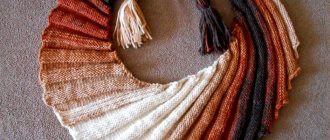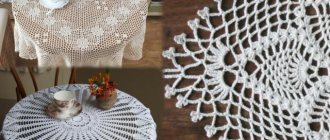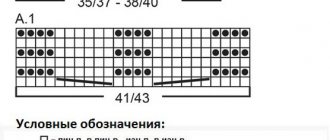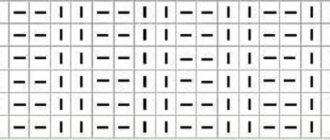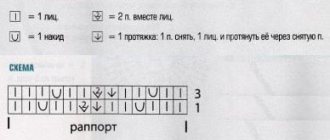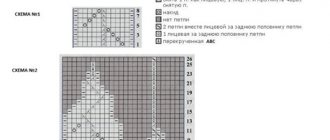- How to wear bactus
- Bactus diagrams for beginners
- Openwork bactus knitted
- Baktus breakwater
- Bactus scarf
- Bactus in garter stitch
- Male bactus
- Children's bactus
Do you want to knit a bactus - beautiful, stylish and fashionable? Or you don't know what it is! In this article we will talk in detail about this wardrobe element, learn how to knit bactus and how to wear it.
How to wear bactus
Bakuts became popular not so long ago and it came to us from the Scandinavian countries, or more precisely from Norway. It is an original headscarf or triangular scarf, which serves as a “warm neckerchief”.
Initially, baktus were part of the national costume and were a distinctive sign of high social status. And as soon as things in the national style came into fashion in Northern Europe, world designers immediately picked up this trend. And today almost every girl has bactus in her wardrobe.
There are many variations of wearing bactus - this is its main advantage in addition to its warming functions.
The first option is like a scarf, tied around the neck. In this case, the corner of the bactus is located in the center, and the ends wrap around the neck and are hidden inside. Perhaps this is a classic way to wear this accessory. In this position, bactus looks good with a shirt, over a turtleneck or under outerwear, like a scarf.
The second option is like a scarf, but the edges wrap around the neck and hang elegantly. This way of wearing bactus is very stylish, it adds some zest to your entire look, regardless of whether it is worn over a T-shirt or jacket.
The third option is when the edges of the bactus are not hidden, but tucked under its corner. In other words, the edges lie at a fundamental angle. Let's demonstrate it below with an example.
The fourth option is to tie the ends in a knot. A very convenient way to wear it, especially when you need to quickly tie a bactus and be outside in five minutes.
And let’s add a few more interesting ways to wear bactus as a fashion accessory.
How to choose and who it will suit
Baktus suits everyone - mainly due to the fact that you can not only choose the ideal size for everyone, but also wrap the product around your neck in different ways. Color and style play an additional role. How to choose an item so that it becomes a decoration of your wardrobe, and not just remains in the closet after purchase:
- popular massive products are suitable for girls with narrow shoulders or those who want to focus attention on the bust;
- thin, small accessories should be chosen by representatives of the “pear” or “inverted triangle” figure type - large volume of hips and small volume of shoulders;
- girls with long necks should be careful with the “Norwegian pattern”, as it visually lengthens it even more;
- select the size of the scarf so that it can be wrapped in different ways and does not sit end to end;
- buy warm accessories for winter or autumn; perhaps there is a need to choose several different styles so as not to combine the same bactus scarf with outerwear;
- take openwork ones for summer and warm spring to create stylish romantic looks;
- to choose a shade, you need to inspect your wardrobe: bright colors are suitable for dark plain raincoats and coats, light colors are suitable for leather items, deep saturated colors are suitable for winter, and pastel colors are suitable for spring or summer;
- pay attention to the quality of the knitting, the composition of the material: bactus not only plays the role of decoration, but also must provide good warmth (in winter and in the mid-season), and allow air to pass through, so it is better to buy things only from natural yarn.
- Ear fungus in humans
- My tailbone hurts when I sit and stand up
- How to remove bags under eyes at home
Bactus diagram for beginners
Even a beginner can tie bactus. But we advise you to choose simple and clear patterns for your first bactus, such as knit or purl stitch.
Some tips:
- First, create a pattern to visually represent the size of the finished bactus.
- Pay special attention to the choice of yarn and knitting needles. Give preference to natural threads, and choose circular knitting needles with thin and flexible fishing line.
- Knit the sample and after WTO, calculate the knitting density.
- The bactus is knitted starting from an obtuse corner (if you imagine the bactus as a triangle) or the main edge (in the picture this is the upper corner). The shape is created by adding loops on both sides.
Let's start knitting from the main edge (the top point of the pattern).
Cast on 6 stitches on the knitting needles and knit 3 stitches. p., 1 p. p, 3 persons. p. Next, knit according to the given pattern.
From the 1st to the 6th rows we knit according to the pattern: that is, on both sides of the knitting, in each front row we increase the number of loops by 6: in each front row we make yarn overs and increases. We knit in this way to the required length - 180 cm, after which we close the loops. To decorate the bactus with tassels in the corners of the scarf, you will need 80 pieces of yarn 30 cm long. These will make 3 tassels 15 cm long.
If you want to crochet a bactus, leave 373 loops (123 row) and knit as follows: knit 2 sts from the knitting needle, then pick up a st and make 1 picot (3VP, 1SC in 1VP) - repeat this 60 times. Finish the second half of the bactus in a mirror image
Example of sizes and diagram for a simple knitted bactus.
Simple bactus for beginners with fringe
Here are some more successful examples of knitting bactus for beginners. Just knit according to the pattern and you will get a new fashion accessory.
We have also selected a number of training videos for you that will help you tie your bactus if you are a beginner!
Video “How to tie BACTUS | The easiest way to knit bactus" channel Easy to knit
Educational video from the Svetalna Kolomiets Knitting School “SCANDINAVIAN SCARF. TRIANGULAR. Knitting needles. MK."
Step-by-step knitting instructions
This scarf can be knitted in any pattern. If traditionally bactus was a homogeneous canvas, now openwork products are popular. You can find many options for crocheting bacti with patterns and descriptions. Beginning craftswomen are recommended to use them.
Openwork
To crochet openwork bactus, it is better to take yarn with cotton or linen thread. Typically, such scarves are worn in the warm season. If you take a woolen thread, it can be worn in winter, but it will be less warm due to the airiness and openwork of the pattern. This scarf goes well with any outfit. It can be worn on the shoulders or on the head, tied in the classic way.
Chains of air loops make the product easy to stretch. And the openwork bactus is knitted simply:
- the pattern consists of two elements, which are reflected in different diagrams;
- the first 7 rows are knitted according to 1 pattern, alternating chains of chain loops and double crochets;
- from the 8th row you need to knit according to the second pattern, making increases in each row;
- The scarf can be tied in any wavy pattern.
Scheme No. 1
Scheme No. 2
Scheme No. 3 and No. 4
Ready product
Openwork knitted bactus
To obtain the effect of airiness and volume of the product, we knit openwork bactus.
Prepare for work:
- Wool or wool+acrylic 300 gr.
- Knitting needles 4 mm
Work process:
Cast on 3 stitches. Knit 6 rows in stockinette stitch. In the sixth row, increase by two stitches. Purl 6 rows and increase again on the sixth row.
Alternate steps 2 and 3 until the height of your bactus is 40 cm. Alternate the front and back stitch, adding one loop in every 2nd row and decreasing one loop in every sixth. This is how the next 30 centimeters are knitted.
Then decrease four stitches at the beginning of every 6th row and add the 1st at the end of each even row, and add the 1st at the beginning of each odd row.
Bactus in garter stitch
Below is the simplest pattern for knitting bactus, which is suitable even for beginners.
Prepare for work:
- Woolen or mixed yarn (wool with acrylic) - 400 g.,
- Knitting needles 4 mm,
- Hook 4.5 mm.
Bosnian
A scarf made with Bosnian knitting is suitable not only for women, but also for men. The result is a rather dense canvas with an original pattern, in which voluminous stripes alternate with mesh. To crochet Bosnian bactus, it is better to take a plain or sectionally colored thread. The pattern uses air loops, connecting stitches and double crochets.
A simple diagram and step-by-step description will help you correctly associate such a bactus:
- First, a chain of air loops is made.
- Then you need to alternate double crochets and connecting stitches up to the 5th row.
- In the 5th row, double crochets and chain stitches alternate.
- The next row is connecting posts.
Continue to stick to this pattern, adding one loop on each side.
Ready product
Scheme
"Lost in Time"
The original bactus with cones was called “Lost in Time”. The alternation of stripes of different patterns, the presence of cones knitted using the “popcorn” method, the combination of bright colors - all this makes this scarf look like traditional Indian shawls. Experienced craftswomen have a lot of scope for imagination; they can swap pieces of the pattern, remove or add their own. But it's best to experiment with shades. With some effort, you can create a real masterpiece that will definitely attract attention and make your image stylish.
At first the pattern may seem complicated, but if you take a closer look and study the pattern well, anyone can handle the product. A detailed master class will help beginning craftswomen who have decided to undertake such complex work. The pattern uses regular air loops alternating with columns. The main thing is to carefully count the number of loops when knitting arches and cones. The pattern consists of 26 rows, which are repeated to the desired size.
№1
№2
№3
№4
Ready product
Japanese
The Japanese bactus model is popular. This is a small scarf without a clearly defined front corner. Its peculiarity is the presence of narrow long ends. They wear a scarf draped over the back of their shoulders. The original alternation of stripes with a mesh pattern makes it suitable for any look. To crochet Japanese bactus, you can use plain yarn; it is recommended to use a different color for finishing.
The pattern is quite simple. This allows you to knit it literally in a day. Instructions:
- Start with 1 loop.
- Alternate three air loops and a double crochet.
- In every second row you need to knit an additional loop.
- You need to knit this way until the number of loops reaches 51.
- After this, a decrease is made in the same way.
- The finished product is tied according to the same pattern, at the end you can thread a thread of a different color between the posts.
Ready bactus
Main canvas
Semicircular
An openwork semicircular scarf looks impressive. The absence of a clearly defined angle makes it universal. This scarf can be worn over a coat or jacket in winter. And if you knit it from thin yarn, it will go well with a jacket or shirt. This scarf will be in demand on a cool summer day or in rainy weather. It can be thrown over your shoulders or tied on your head. The openwork pattern makes it airy and light.
Crocheting a semicircular bactus is quite simple. A detailed diagram with a description will help even a novice craftswoman cope with such work. The main thing is to choose the right type of yarn and color; you can alternate two shades. The work flow is as follows:
- cast on 7 air loops (VP);
- work a double crochet (dc) into the first stitch;
- then 2 VP and CH in the same place;
- tie the resulting semicircle using 16 dc;
- continue working according to the pattern, alternating air loops and columns to the desired size.
Wavy
Of all the fashionable bacti, the original scarf with a voluminous wavy pattern stands out. It is suitable for any woman who wants to stand out, as it looks very impressive. The knitting pattern is quite simple, but you need to follow all the recommendations exactly. The number of rapports should be odd, and their decrease should be uniform, then you will get beautiful waves. A medium size scarf will require approximately 200 grams of yarn. It is best to choose a smooth, frizz-free thread.
You need to start with a chain of air loops. It is recommended to cast on 324 stitches. This is 15 repeats of 19 loops. In the first rows, it is necessary to ensure the correct distribution of pattern elements. It is knitted with half-stitches and raised stitches. To get a wavy three-dimensional pattern, you need to cling them to the leg of the column of the previous row. From the 5th row on both sides of the scarf, the reduction of loops begins. From the 11th row the outline of the triangle should already be visible. At the end, the last rapport is knitted, which is the top of the scarf.
Symbols Scheme No. 1 Scheme No. 2
Scheme No. 3
Ready product
Option "Breakwater"
To knit this product, use the diagrams and descriptions for knitting bactus. So, prepare a yarn of medium thickness. The value of 150 or 200 g depends on the length of the future product. Prepare a marker and knitting needles No. 3, 4.
You can distinguish such varieties, as can be seen in the photo of knitting bactus.
The front surface is used for these purposes. This means using exclusively knit stitches in the knit rows. In purl rows it is necessary to use purl loops.
The next option is to use purl stitch. It is performed in the opposite order to the previous type. That is, purl loops are used in the front rows, and knit loops are used in the purl rows.
Simple options
It is worth noting that bactuses made in the classic style are made using garter stitch. In this case, all loops are knitted with facial loops. Carius is knitted with stockinette stitch, for example. This is one of the interesting varieties of triangle.
The advantage of such models is that in cold or rainy weather they will definitely keep you warm. This product is universal, suitable for both parents and children.
For beginners, the process is not difficult. To do this, you need to familiarize yourself with the master class on knitting bactus with knitting needles. In general, to knit a stylish, quite beautiful charm you will need approximately 1 - 2 skeins of yarn. For knitting, the best option for knitting needles will be No. 4, 5. The positive thing is that the fabric rises quite quickly during the process.
Note! You should not knit on thin spitz dogs. This is unacceptable for knitting bactus, as tight knitting looks a bit rough. It is not able to form soft folds, which makes the product uncomfortable to wear.
During knitting, you should guide the needles from the tip to the center, gradually moving to the other end of the scarf.
Experienced professionals advise beginners to pay attention to the following nuances. It is necessary to make yarn overs in order to increase the fabric, knitting with rolled knit stitches in the purl rows. Use a centimeter to measure the exact middle of the product. The optimal width of bactus is considered to be 28-30 cm.
If you are interested in a detailed overview of modern home appliances, we recommend visiting the Internet resource: tehnikaportal.ru
The product is quite fashionable, it can complement not only a winter look, but also a summer one. It is necessary to combine stylish details and show imagination.
Openwork bactus knitted
A girl wearing an openwork bactus looks especially feminine. It adds some lightness to the whole look. Knitting an openwork bactus is not difficult, the principle is the same as when knitting with satin stitch. But there is one particular difference: openwork bactus headscarves have a border. A border is the openwork edge of a knitted scarf, scarf or bactus. And so let's move on to examples.
Openwork bactus (shawl) knitted in soft peach color
A very beautiful neck accessory with an openwork pattern and border. Its dimensions: width - 178 cm, height - 76 cm. To knit openwork bactus with knitting needles you will need: yarn (100% merino, 100 g/307 m) - 3 skeins, circular knitting needles No. 3.5; 2 stocking needles; markers; add. thread for casting on loops. Basic patterns: garter stitch, stockinette stitch, openwork pattern according to the pattern, border according to the pattern. Knitting density:
1 repeat = 18 loops = 9 cm.
You can find a more detailed description by following the link.
Air shawl knitted in an openwork pattern
An airy shawl or an openwork bactus knitted with an openwork pattern for sophisticated women will envelop you in warmth and tenderness, especially if you use natural threads in your work, for example, pure down or merino wool, as recommended in the description.
Knitting density: 19 loops = 10 cm.
Size: 124 cm by 65 cm
General recommendations for knitting bactus
As in any other job, attention to detail and detail determines the final result of the work. Please note the following:
The length of the scarf is on average from one to one and a half meters. This is not a law, and it can certainly be broken. However, according to experience, a product less than 50 centimeters long looks unfinished, and more than one and a half meters turns into a shawl.
You will need about 300-400 grams of yarn, but it is better to take it with a small reserve. If you are knitting a pattern for spring and summer, then choose cotton with acrylic. The product will wrinkle less.
For bactus for autumn and winter, give preference to blended acrylic and wool yarn. Your bactus will be soft, pleasant to the body and will last for a long time.
The process always goes from the narrow part of the scarf to the wider one.
Whatever pattern you choose, in each row that is a multiple of 4, you need to add one loop. The first and last loops are knitted so that your bactus does not curl.
Bactus scarf
Can a neck accessory look like a scarf, headscarf and bactus at the same time? You will probably question this possibility. But in fact there is one very original solution.
This model is original in that one end is wide, like a scarf, and the other is narrow, like a bactus or shawl. This format makes it possible to create beautiful and extraordinary images.
In order to knit such a bactus you will need: Rowan Fine Art yarn (45% wool, 20% mohair, 10% silk, 25% polyamide, 100g/140 m) - 200 g, section-dyed in blue tones; circular knitting needles No. 3.25 mm. You can replace the yarn with any other yarn of similar weight and yardage.
Basic patterns:
Facial surface: faces. R. - persons p., out. R. - purl P.
Knitting density: 26 p. x 34 p. = 10 x 10 cm.
From 3 stitches, knit 3 stitches (3/3): from 3 stitches, knit 1 knit, 1 yarn over, 1 knit. P.
Description of knitting a scarf-kerchief-bakuts: on circular knitting needles No. 3.25, cast on 151 sts. Row 1 (knits): knit. n. Row 2: knit. n. Row 3: knit. n. Row 4: K2. p., out. to the last 2 p., k2. n. Row 5: K2. p., * 3/3, 1 persons. P.; repeat from * to last 5 sts, 3/3, k2. n. Row 6: K2. p., out. to the last 2 p., k2. p. Row 7: knit. p. Row 8: knit. P.
Row 9: Knit. p. Row 10: K2. p., out. to the last 2 p., k2. p. Row 11: k4. p., * 3/3, 1 persons. P.; repeat from * to last 7 sts, k3/3, k4. p. Row 12: k2. p., out. to the last 2 p., k2. p. Repeat these 1-12 rows again, then 1-8 rows x 1 time.
Next knit with decreases. Row 1 (knit): K9. p., (remove 1 p., 1 knit. p., throw the removed loop over the knitted one) - decrease, knit. to the end of the row = 150 p. Rows 2, 4: k2. p., 5 p. p., 2 persons. p., out. to the last 9 p., k2. p., 5 p. p., 2 persons. n. Row 3: K3. p., 3/3, 3 persons. p., (remove 1 p., 1 knit. p., throw the removed loop over the knitted one), knit. to the last 6 p., 3/3, k3. p. = 149 p.
Row 5: K9. p., (remove 1 p., 1 knit. p., throw the removed loop over the knitted one) - decrease, knit. to the end of the row = 148 sts. Row 6: k9. p., out. until the last 9 p., 9 knits. p. Repeat rows 1-6. Repeat decreases every 4th row. Knit until 21 stitches remain. Work 3 rows right after row 6. Next row (persons): 9 persons. p., remove 1 p., k2 together, throw the removed loop over the knitted one, k9. p. = 19 p.
Next row: k2. p., out. to the last 2 p., k2. p. Next row: 3 persons. p., (3/3, 2 knit. p.), 3 times, 1 knit. p. Next row: 2 persons. p., out. to the last 2 p., k2. p. Next row: 2 persons. p., remove 1 p., 1 person. p., throw the removed loop over the knitted one, knits. to the last 4 p., k2 together, k2. p. = 17 p. Next row: knit. n. Next row: persons. p. Next row: 2 persons. p., out. to the last 2 p., k2. P.
Next row: K2. p., remove 1 p., 1 person. p., throw the removed loop over the knitted one, k1. p., (3/3, 1 knit. p.), 2 times, 2 knits together, 2 knits. p. = 15 p. Next row: k2. p., out. to the last 2 p., k2. p. Next row: 2 persons. p., remove 1 p., 1 person. p., throw the removed loop over the knitted one, k7. p., 2 persons together, 2 persons. p. = 13 p. Next row: knit. p. Next row: 2 persons. p., remove 1 p., 1 person. p., throw the removed loop over the knitted one, knits. to the last 4 p., k2 together, k2. p. = 11 p. Next row: k2. p., out. to the last 2 p., k2. P.
Next row: K2. p., remove 1 p., 1 person. p., throw the removed loop over the knitted one, 3/3, k2 together, k2. p. = 9 p. Next row: k2. p., 5 p. p., 2 persons. p. Next row: 2 persons. p., remove 1 p., 1 person. p., throw the removed loop over the knitted one, k1. p., 2 persons together, 2 persons. p. = 7 p. Next row: k2. p., remove 1 p., k2 together, throw the removed loop over the knitted one, k2. p. = 5 p. Next row: 1 person. p., remove 1 p., k2 together, throw the removed loop over the knitted one, k1. p. = 3 p. Close off the remaining 3 p.
Bactus in garter stitch
Garter stitch bactus is an option for beginners or for those who want to try their hand at knitting such neck accessories.
For knitting you will need: 400 grams of yarn, knitting needles No. 6 Knitting density: 18 loops X 30 rows. You can knit any other yarn and follow the further description of the knitting progress.
Approximate dimensions : 28 cm by 165 cm without border, 33 cm by 190 cm with border
Legend:
CO = starting row or cast-on edge K (knit) knit stitch ST(S) = loop S1 = slip one stitch - slip one stitch without knitting YO = Yarn over by moving the right needle relative to the working thread as when knitting a knit stitch. K2tog (knit two (2) stitches together) = knit two stitches together
Notes/Abbreviations:
K5 times into next stitch - knit 5 stitches as follows: Loop front, back, front, back, front of next stitch
Pass first 4 stitches over 5th - Pass the first 4 stitches over the 5th stitch - insert the left needle into the 4th stitch on the right needle, pass it over the 5th stitch, repeat with the 3rd, 2nd and 1st stitch
How to knit bactus in garter stitch:
Cast on 5 stitches on the knitting needles. Row 1: knit stitches Row 2: S1, K to last 2 STS, YO, K1, K5 times into last ST Row 3: K5, pass first 4 STS over 5th ST, K to end Row 4: S1, K to the end Row 5: K to end Row 6: S1, K to end Row 7: K to end Repeat Row 2 x 7 38 more times. You have completed one part of the scarf. Next, work Rows 8 - 13 as follows: Row 8: S1, K to last 3 STS, YO, K2Tog, K5 into last st Row 9: K5, pass first 4 STS over 5th ST, K to end Row 10: S1, K to last 3 STS, K2Tog, K1 Row 11: K to end Row 12: S1, K to end Row 13: K to end Repeat Rows 8 to 13 until 5 stitches remain on left, ending with 13 next. Wash the bactus and leave it to dry on a horizontal surface. Once dry, steam! Master class from the channel “Olga Koltsova Knitting” Bactus in garter stitch for beginners
Male bactus
You are mistaken if you think that bactus is exclusively a women's accessory. A men's bactus, like a regular scarf, does not go badly with a coat and naturally fits perfectly under a down jacket. The knitting principle is the same as for knitting women's bactus. The only exception is: more restrained colors and the absence of ruffles and openwork borders. although these are only conditional exceptions.
How to knit a male bactus with knitting needles?
Size: 150 cm.
You will need: 200 g gray Qua yarn! Andes (65% wool, 35% alpaca, 50 m/50 g), needle size 8. Stockinette stitch: knit. R. - persons p., out. r.-iz. P.
Knitting density. Persons stitch: 11 p. and 15 r. = 10 x 10 cm. Description of work: cast on 3 stitches and knit. stitch, making additions from the right edge as follows: at the beginning of each knit. R. after chrome perform 1 yarn over, purl this yarn over. cross. At a total height of 75 cm, there should be 58 stitches in the work. Knit 2 rows on all loops, then decrease from the right edge as follows: at the beginning of each knit. R. after chrome perform 1 stretch (slip 1 stitch as knit, 1 knit and pull it through the removed stitch). Decrease until there are 3 stitches left in the work, then bind off the stitches.
Here are some examples of images with male bacti:
